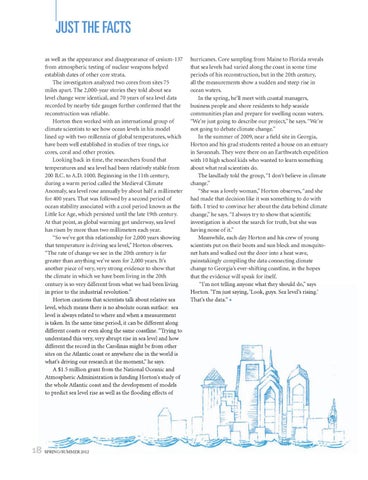as well as the appearance and disappearance of cesium-137 from atmospheric testing of nuclear weapons helped establish dates of other core strata. The investigators analyzed two cores from sites 75 miles apart. The 2,000-year stories they told about sea level change were identical, and 70 years of sea level data recorded by nearby tide gauges further confirmed that the reconstruction was reliable. Horton then worked with an international group of climate scientists to see how ocean levels in his model lined up with two millennia of global temperatures, which have been well established in studies of tree rings, ice cores, coral and other proxies. Looking back in time, the researchers found that temperatures and sea level had been relatively stable from 200 B.C. to A.D. 1000. Beginning in the 11th century, during a warm period called the Medieval Climate Anomaly, sea level rose annually by about half a millimeter for 400 years. That was followed by a second period of ocean stability associated with a cool period known as the Little Ice Age, which persisted until the late 19th century. At that point, as global warming got underway, sea level has risen by more than two millimeters each year. “So we’ve got this relationship for 2,000 years showing that temperature is driving sea level,” Horton observes. “The rate of change we see in the 20th century is far greater than anything we’ve seen for 2,000 years. It’s another piece of very, very strong evidence to show that the climate in which we have been living in the 20th century is so very different from what we had been living in prior to the industrial revolution.” Horton cautions that scientists talk about relative sea level, which means there is no absolute ocean surface: sea level is always related to where and when a measurement is taken. In the same time period, it can be different along different coasts or even along the same coastline. “Trying to understand this very, very abrupt rise in sea level and how different the record in the Carolinas might be from other sites on the Atlantic coast or anywhere else in the world is what’s driving our research at the moment,” he says. A $1.5 million grant from the National Oceanic and Atmospheric Administration is funding Horton’s study of the whole Atlantic coast and the development of models to predict sea level rise as well as the flooding effects of
18 SPRING/SUMMER 2012
hurricanes. Core sampling from Maine to Florida reveals that sea levels had varied along the coast in some time periods of his reconstruction, but in the 20th century, all the measurements show a sudden and steep rise in ocean waters. In the spring, he’ll meet with coastal managers, business people and shore residents to help seaside communities plan and prepare for swelling ocean waters. “We’re just going to describe our project,” he says. “We’re not going to debate climate change.” In the summer of 2009, near a field site in Georgia, Horton and his grad students rented a house on an estuary in Savannah. They were there on an Earthwatch expedition with 10 high school kids who wanted to learn something about what real scientists do. The landlady told the group, “I don’t believe in climate change.” “She was a lovely woman,” Horton observes, “and she had made that decision like it was something to do with faith. I tried to convince her about the data behind climate change,” he says. “I always try to show that scientific investigation is about the search for truth, but she was having none of it.” Meanwhile, each day Horton and his crew of young scientists put on their boots and sun block and mosquitonet hats and walked out the door into a heat wave, painstakingly compiling the data connecting climate change to Georgia’s ever-shifting coastline, in the hopes that the evidence will speak for itself. “I’m not telling anyone what they should do,” says Horton. “I’m just saying, ‘Look, guys. Sea level’s rising.’ That’s the data.” ◆
